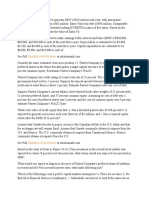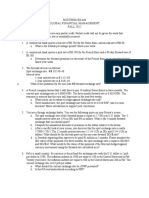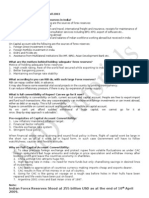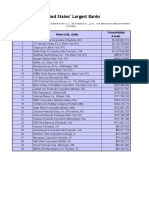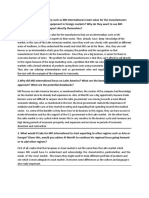0 ratings0% found this document useful (0 votes)
Assignment On IBF
Assignment On IBF
Uploaded by
Kefyalew KelebThis document outlines 11 questions for an international business finance assignment. The questions cover topics such as methods of international business, factors that affect trade flows and foreign direct investment, exchange rate systems, currency strength, motivations for international expansion, multi-country investment analysis, purchasing power parity, triangular arbitrage, currency hedging strategies, and a foreign acquisition case study. Students are asked to define concepts, analyze scenarios, perform calculations, compare alternatives, and make recommendations.
Copyright:
© All Rights Reserved
Available Formats
Download as PDF, TXT or read online from Scribd
Download as pdf or txt
Assignment On IBF
Assignment On IBF
Uploaded by
Kefyalew Keleb0 ratings0% found this document useful (0 votes)
This document outlines 11 questions for an international business finance assignment. The questions cover topics such as methods of international business, factors that affect trade flows and foreign direct investment, exchange rate systems, currency strength, motivations for international expansion, multi-country investment analysis, purchasing power parity, triangular arbitrage, currency hedging strategies, and a foreign acquisition case study. Students are asked to define concepts, analyze scenarios, perform calculations, compare alternatives, and make recommendations.
Original Title
Assignment on IBF (2)
Copyright
© © All Rights Reserved
Available Formats
PDF, TXT or read online from Scribd
Share this document
Did you find this document useful?
Is this content inappropriate?
This document outlines 11 questions for an international business finance assignment. The questions cover topics such as methods of international business, factors that affect trade flows and foreign direct investment, exchange rate systems, currency strength, motivations for international expansion, multi-country investment analysis, purchasing power parity, triangular arbitrage, currency hedging strategies, and a foreign acquisition case study. Students are asked to define concepts, analyze scenarios, perform calculations, compare alternatives, and make recommendations.
Copyright:
© All Rights Reserved
Available Formats
Download as PDF, TXT or read online from Scribd
Download as pdf or txt
0 ratings0% found this document useful (0 votes)
Assignment On IBF
Assignment On IBF
Uploaded by
Kefyalew KelebThis document outlines 11 questions for an international business finance assignment. The questions cover topics such as methods of international business, factors that affect trade flows and foreign direct investment, exchange rate systems, currency strength, motivations for international expansion, multi-country investment analysis, purchasing power parity, triangular arbitrage, currency hedging strategies, and a foreign acquisition case study. Students are asked to define concepts, analyze scenarios, perform calculations, compare alternatives, and make recommendations.
Copyright:
© All Rights Reserved
Available Formats
Download as PDF, TXT or read online from Scribd
Download as pdf or txt
You are on page 1/ 3
Gamby Medical & Business College
Department of Accounting and Finance
MSc in Accounting and Finance
International Business Finance Assignment (30%)
1. There are several methods by which firms can conduct international
business. Mention and describe at least four methods. Describe also
direct foreign investment (DFI) by relating to those methods.
2. Several factors affect International Trade Flows. These factors include: i)
Inflation, ii) National income, iii) Tariff, iV) Subsidies for exporters, iV)
Depreciation of currency. Show how each of the above factors impact
(increase or decrease or no impact) on imports, exports and current
account.
3. There are several factors that affect Direct Foreign Investment (DFI).
Mention at least three factors and describe how each factor influence
DFI.
4. Exchange rate systems are classified into five categories according to
the degree by which government controls them. Mention and describe
at least four exchange rate systems? Which exchange rate system
does Ethiopia follow currently?
5. The strength of currency is a measure of the level of economic
development of a country. Do you agree? Explain by providing both
theoretical and practical arguments.
6. Why are firms motivated to expand their business internationally? We
have three theories explaining this. Please mention and describe these
theories.
7. Mr. Daniel resides in the United States of America and currently he is
contemplating in which country bank to deposit his wealth of $100,000.
For this purpose, he is considering three alternative countries-Ethiopia,
Great Britain, and U.S.A. The current spot rate is as follows: U.S.D. 1=Br.20
and £1=U.S.D.1.5. Banks in Ethiopia are expected to pay an interest
rate of 5% per annum, British banks pay 3% per annum and U.S. banks
pay 2% per annum. The inflation rate per annum for Ethiopia, Britain
and United States is expected to be 10%, 7% and 6% respectively.
Assume interest rates and inflation rates will be constant every year
throughout the next five years. Use purchasing power parity (PPP) to
forecast exchange rates five years from now. Assume further that there
is no tax on interest for all the three countries. Mr. Daniel has a five year
investment horizon.
Required:
A. During the five year investment horizon, how much U.S. dollar will
Mr. Daniel obtain if he deposits in Ethiopia? Great Britain? United
States?
B. Which country do you recommend for Mr. Daniel to deposit his
money?
8. Assume that the United States inflation rate is expected to be 1% over
the next year, while Ethiopian inflation rate is expected to be 6% over
the next year. Assume the spot rate is as follows: 1 U.S.D= 20 Birr
Required:
A. Assuming PPP, determine the percentage change in the value of
Birr?
B. What is the forecasted value of Birr at the end of one year?
9. Assume that a bank has quoted the British pound (£) at $1.50, the
Newzland dollar (NZ$) at $ 0.50 and the cross exchange rate at
1£=NZ$ 2.95.
Required:
A. Determine the correct cross exchange rate.
B. If you have $ 10,000, how many U.S. dollars will you end up with in
one round trip triangular arbitrage?
C. How much is the gain from triangular arbitrage?
10. Blue Demon Bank expects that the Chinese currency (the yuan) will
depreciate against the dollar from its spot rate of $0.15 to $0.14 in 30
days. The following interbank lending and borrowing rates exist:
Lending Rate Borrowing Rate
U.S. dollar 8.0% 8.3%
Chinese Yuan 8.5% 8.7%
Assume that Blue Demon Bank has a borrowing capacity of either $10
million or 70 million Yuan in the interbank market, depending on which
currency it wants to borrow.
A. How could Blue Demon Bank attempt to capitalize on its
expectations without using deposited funds? Estimate the profits
that could be generated from this strategy.
B. Assume all the preceding information, with this exception: Blue
Demon Bank expects the Yuan to appreciate from its present spot
rate of $0.15 to $0.17 in 30 days. How could it attempt to capitalize
on its expectations without using deposited funds? Estimate the
profits that could be generated from this strategy.
11. Dragon Inc, of Moorhead purchased a Korean company that
produces plastic nuts and bolts for auto manufacturers. The purchase
price was Won7,030 million. Won1,000 million has already been paid
and the remaining Won6,030 million is due in six months. The current
spot rate is Won1,200/$, and the 6-month forward rate is Won1,260/$
Additional data:
a. Six-month Korean interest rate: 16.00% p.a.
b. Six-month US interest rate: 4.00% p.a.
c. Six-month call option on Korean Won at 1,260 with a premium of
Won33.33/$
d. Six-month put option on Korean Won at 1200 with a premium of
Won41.67/$
e. Dragon can invest at the rates given above or borrow at 2% p.a.
above those rates. Dragon’s cost of capital is 25%.
f. Assume any new proceeds are invested in T-bills (not used to
replace borrowings nor invested in the firm’s tangible assets)
g. Any new funds can be raised at the borrowing rate. Option
premium is also financed using borrowings.
Compare hedging alternatives and make a recommendation.
You might also like
- Series 65 Exam Practice Question Workbook: 700+ Comprehensive Practice Questions (2024 Edition)From EverandSeries 65 Exam Practice Question Workbook: 700+ Comprehensive Practice Questions (2024 Edition)No ratings yet
- Evolution of Entrepreneurship in The Philippines85% (20)Evolution of Entrepreneurship in The Philippines17 pages
- Solution Chapter 6 International FinanceNo ratings yetSolution Chapter 6 International Finance6 pages
- Select Technology and Business College Department of Accounting and Finance100% (1)Select Technology and Business College Department of Accounting and Finance8 pages
- International Parity Condition Numericals With AnsNo ratings yetInternational Parity Condition Numericals With Ans8 pages
- International Finance Assignment Apple CorporationNo ratings yetInternational Finance Assignment Apple Corporation3 pages
- FMP Foreign Exchange Markets Practice Questions 1 1No ratings yetFMP Foreign Exchange Markets Practice Questions 1 112 pages
- IBF301 Chapter 06 Problem-Solving ExercisesNo ratings yetIBF301 Chapter 06 Problem-Solving Exercises6 pages
- University of Gujrat: Department of Management SciencesNo ratings yetUniversity of Gujrat: Department of Management Sciences2 pages
- Assignment4 - International Parity ConditionsNo ratings yetAssignment4 - International Parity Conditions2 pages
- International Economics - Mock Midterm ExamNo ratings yetInternational Economics - Mock Midterm Exam8 pages
- MID-TERM Examination # 1 (30%) : Interest Paid 6 MillionNo ratings yetMID-TERM Examination # 1 (30%) : Interest Paid 6 Million7 pages
- 5) Exam Is Due Back Before Midnight (EST) On Nov 5: WWW - Federalreserve.govNo ratings yet5) Exam Is Due Back Before Midnight (EST) On Nov 5: WWW - Federalreserve.gov3 pages
- Final Exam: 1 Uncovered Interest Parity and Taxation: 10 MinutesNo ratings yetFinal Exam: 1 Uncovered Interest Parity and Taxation: 10 Minutes10 pages
- Indian Forex Reserves Stood at 255 Billion USD As at The End of 10 April 2009No ratings yetIndian Forex Reserves Stood at 255 Billion USD As at The End of 10 April 20094 pages
- How to Reverse World Recession in Matter of Days: Win 10 Million Dollar to Prove It WrongFrom EverandHow to Reverse World Recession in Matter of Days: Win 10 Million Dollar to Prove It WrongNo ratings yet
- The Mineral Industry of The Central African RepublicNo ratings yetThe Mineral Industry of The Central African Republic2 pages
- Role of Govt. in A Mixed Economy.: Presented By, "Summer of 69"100% (1)Role of Govt. in A Mixed Economy.: Presented By, "Summer of 69"17 pages
- I. Introductory Page: A. Name and Address of BusinessNo ratings yetI. Introductory Page: A. Name and Address of Business3 pages
- Research On Merger Between PNB, OBC & UBINo ratings yetResearch On Merger Between PNB, OBC & UBI10 pages
- Common Abbreviations of Garments Technology67% (3)Common Abbreviations of Garments Technology3 pages
- Hummus Bar: Dipping Into Into International Markets: Group 3No ratings yetHummus Bar: Dipping Into Into International Markets: Group 37 pages
- Eastern Bank LTD: Effective Date: Exchange RateNo ratings yetEastern Bank LTD: Effective Date: Exchange Rate2 pages
- Statement of Bonus For The Bonus Month - 2021 OCTOBERNo ratings yetStatement of Bonus For The Bonus Month - 2021 OCTOBER2 pages
- (Revised) Officer of Bank Financial Institution Affidavit100% (11)(Revised) Officer of Bank Financial Institution Affidavit1 page
- Case Study Importing and Exporting SolutionNo ratings yetCase Study Importing and Exporting Solution2 pages


